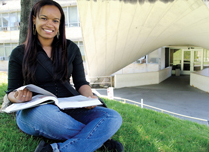Gateway to Opportunity?
When 20-year-old Yaritza Agramonte transferred to
Instead, Agramonte floundered for a semester, taking courses in American history and remedial math, unaware of the much more rigorous requirements for the nursing degree she sought.
By the time a friend pointed her to a Web site that set her straight, Agramonte, who lives at home with her parents and wanted to help pay the bills, had committed herself to a 40-hour-per-week job at Staples. "My grades took a beating for a while," she says of her double load, adding that she's since quit the job. "From now on, I'm going to concentrate on my studies."
Community colleges, established to give every American low-cost access to higher education, are a first point of entry to higher education for many, enrolling nearly half of all
"If you are interested in educational equity, community colleges should be central to your agenda," says Thomas Bailey, George and Abby O'Neill Professor of Economics and Education at Teachers College and Director of TC's Community College Research Center (CCRC). "Educators and policymakers are justifiably concerned about opening up access to the elite, selective colleges and universities, yet there are more Hispanic and black students enrolled in the two community colleges in the
For many, community college is a ticket to economic stability - or at the very least to a higher paying job. Indeed, those who complete associate degrees, for example, often earn between 20 and 30 percent more than individuals with no more than a high school degree.
Yet stories like Yaritza Agramonte's are surprisingly common in the community college world. Bright, motivated students often arrive unprepared, whether financially, academically or otherwise. Half of all entering students do not complete their first year. Eight years after entering, only six percent have received a certificate, 16 percent an associate degree and 18 percent a bachelor degree.
Why? Certainly students' skills are part of the challenge: up to 75 percent of those who enter these open-access institutions are unable to do college-level work, either because of under-preparedness or because of a language issue. There are also problems within the institutions that drive otherwise ambitious students out of the classroom. Bailey and his staff at CCRC engage in rigorous research to identify these problems and suggest possible solutions.
One increasingly popular strategy designed to better prepare high school students for college is dual enrollment, in which high school students take college-level courses prior to graduation.
"It seems contradictory - why take students who aren't doing well in high school and put them into college-level courses early?" Bailey asks. "You'd expect that either the courses would have prerequisites that make them inaccessible to the people you're trying to reach or else that they're so watered down that you'd produce the same students, only now with an associate degree. But the rationale is that by expecting more from these students - by giving them a taste of college and treating them as more mature - you can motivate them to do better. It's very optimistic."
Politicians on both sides of the aisle support the idea. Last year, Margaret Spellings, U.S. Secretary of Education, announced a $125 million proposal by the President to increase access to these programs.
Yet despite the potential benefits, Bailey raises an important caveat: "No one's done any research to show that students in dual enrollment programs go to college at a higher rate or do any better."
CCRC is working to find a more definitive answer. Last year, the center released a report, funded by the U.S. Department of Education, entitled "Pathways to College Access and Success." In it, Katherine Hughes, Melinda Mechur Karp, Baranda Fermin and Bailey found that the most effective components of dual enrollment programs are the ones that ready students for specific aspects of a college's culture. The authors awarded high marks to a City University of New York program that gives immigrant high school students remedial classes before they enroll in a community college.
That's important, because "remediation rates at community colleges, particularly for students who are most at risk, are very high," Karp explains. "High school graduates think they are ready for college, and then they take placement tests and find they need remediation. It can be very disheartening, and many end up dropping out." Providing remedial courses to students while they are still in high school may ensure that they are prepared for college-level work when they enter a community college, thereby eliminating one barrier to graduation.
The study bases its judgments solely on the benefits perceived by students and teachers. But now CCRC is looking at whether dual enrollment programs actually improve college graduation rates.
CCRC recently received a $10 million grant to create a federal research center that will study the efforts of two- and four-year colleges to boost educational access and graduation rates. Meanwhile, the center is working on a major initiative called Achieving the Dream: Making Community Colleges Count, funded by the Lumina Foundation for Education, KnowledgeWorks Foundation and the Nellie Mae Education Foundation. In a recent study, titled "Opening the Black Box: Institutional Research at Community Colleges," Bailey, Vanessa Smith Morest and a team of researchers found that these institutions have surprisingly little information and research that would allow them to understand the barriers within the colleges that students face and to design measures to overcome those barriers.
More specifically, they learned that Institutional Research (IR) offices rarely conduct long-term studies of the academic performance of students and student subgroups, and that faculty rarely help design institutional research or receive its findings.
Would changing the IR picture transform community colleges into the gateway to opportunity that they were originally meant to be? Not by itself. But it could nudge an institution to provide the kind of information or help that might keep a struggling student from giving up. For Yaritza Agramonte and others like her, that could be a critical difference indeed.
Published Wednesday, Sep. 20, 2006
